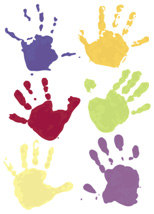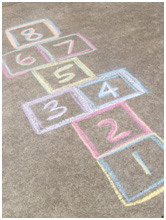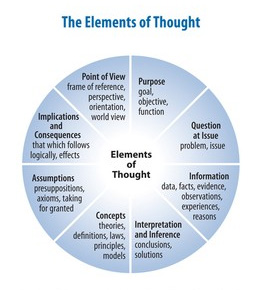
Using Critical Thinking to Support Decision-Making in Early Childhood Intervention
Dr. Christine Myers

The purpose of this instructional product is to introduce students to the Paul and Elder Model as a way to enhance their critical thinking as a rehabilitation professional working in early childhood.
 As a professional who works with young children with disabilities and their families, you have the responsibility of providing high quality services to address multiple needs. Successful outcomes for children and families depend on a strong appreciation of family-centered services and service delivery focused on enhancing a child's participation in the natural or least-restrictive environment. Achievement of positive outcomes depends on decisions that are made in collaboration with the family and other team members, such as decisions about specific intervention approaches and participation in different types of early childhood programs. The decisions that you and other team members make may potentially impact the children and families you work with for years to come, so it is important for you to have a clear understanding of why you are advocating for one choice or another.
As a professional who works with young children with disabilities and their families, you have the responsibility of providing high quality services to address multiple needs. Successful outcomes for children and families depend on a strong appreciation of family-centered services and service delivery focused on enhancing a child's participation in the natural or least-restrictive environment. Achievement of positive outcomes depends on decisions that are made in collaboration with the family and other team members, such as decisions about specific intervention approaches and participation in different types of early childhood programs. The decisions that you and other team members make may potentially impact the children and families you work with for years to come, so it is important for you to have a clear understanding of why you are advocating for one choice or another.
In order to have a deep understanding of why one option is the best out of several possible options and in order to explain your reasoning to families and professional team members, you need to think critically about the issues rather than making a quick decision based on your own biases or those of other team members. This module will introduce you to the Paul and Elder Model of Critical Thinking, a framework that we will be using throughout the course as we analyze and evaluate our own thinking about a variety of issues related to working with young children with special needs. We will practice using the concepts from the Paul and Elder Model as we review early childhood policy, research, and intervention strategies. We will learn to use the model to support our position on different issues pertaining to young children with special needs.
After reviewing the 8 Elements of Reasoning used in analyzing one's thinking, students will review a model for how to use critical thinking to make a team decision about a child's placement in an inclusive early childhood classroom. Students will then complete two activities using the Paul and Elder Model while working through the module.
After completing this instructional product, participants will be able to:
1. Demonstrate an understanding of how reflective reasoning supports decision-making in early childhood.
2. Analyze an issue/situation/problem using the Paul and Elder Eight Elements of Reasoning.
Before you continue reading, respond to the following questions:
1) What is your concept of critical thinking? (you can provide a description or give an example),
2) Describe a situation in school or in the clinic (fieldwork, internship, etc.) in which you thought through something critically, and
3) Describe a situation in school or in the clinic (fieldwork, internship, etc.) in which you did not think through something critically (adapted from Nosich, 2005).

"Critical thinking" is not the same as thinking. Thinking is a process that involves drawing conclusions about something, forming concepts, making decisions, and having a point of view. It's any activity in which you process things with your mind. So, forming a closely reasoned judgement after paying close attention to the evidence is an example of thinking. But so is jumping to a conclusions without considering any evidence. Similarly, weighing both sides of an issue and carefully checking for biases that might unfairly influence a decision is an example of thinking. But so is stubbornly holding on to prejudices and using stereotypes to judge people.
Although all four descriptions are examples of thinking and reasoning, only the first and third are examples of critical thinking. Two conditions are necessary if thinking is to be critical thinking. First, the thinking has to be reflective; it has to involve thinking-about-my-thinking. Second, this reflective thinking must meet high standards; it must be reflective reasoning that is done well." (Nosich, 2005)
Reflective reasoning is not only a benefit to us; it is also a benefit to the families and children who receive our services. You might even think of reflective reasoning as an ethical responsibility for professionals working in the fields of healthcare and education. It ensures that we have considered all options, gathered necessary information, and made a knowledgeable recommendation that is not clouded by personal bias.

So, how can we make certain we are thinking critically, especially when difficult decisions need to be made? The 8t Elements of Thought, also known as the 8 Elements of Reasoning, provide a first step to understanding how to critically think through an issue. Take a moment now to review the diagram that summarizes these elements
1. Purpose
2. Problem (or the Question at Issue)
3. Information or Evidence
4. Interprestation and Inferences
5. Concepts
6. Assumptions
7. Implications and Consequences
8. Point of View (Perspectives)
Instructions for Students:
1. Read the information below.
2. Access the websites via the links provided.
3. When you have reviewed the information provided on the websites, click on the "Back" button on your Internet browser to return to this instructional product.

The elements provide a foundation for reflecting on your thinking. As you look at the circle of elements, I imagine that many of the terms are familiar to you. In fact, at your current level of education you have most likely used several or all of the elements when engaged in thinking about an issue. Take some time to familiarize yourself with the terms and their meanings in relation to reflective reasoning:

Instructions for Students:
1. Read the information below.
2. Access the video via the link provided below.
3. When you have reviewed the video provided, click on the "Back" button on your Internet browser to return to this instructional product.
Nosich (2005) also includes context (the background of the reasoning) and alternatives (different choices that could be made in the reasoning) as a part of reflective reasoning (p. 47). It is important to take into account the context of the situation, issue, or question, as well as the possible alternatives. In order to gain an understanding of what reflective reasoning with the elements looks like, here is an example that is based on the issue of inclusion for a young child with a disability:
The following clip shows a parent, early intervention service provider, and team members from the preschool program at a local school district at a child's first Individualized Education Progam (IEP) meeting.
View the video clip (link provided below) and then continue on to the activity
http://media.eku.edu/mdr/media/ot/myers/TheFirstIEP_Parent_Perspectives.wmvIn the above video clip, the school administrator presents the parent with a plan to place the child into a self-contained preschool special education classroom. The parent and early interventionist both disagree, arguing that the child should be placed in an inclusive general education setting.

Using the 8 Elements of Thought, also known as the 8 Elements of Reasoning, your instructor has analyzed the issue from two different perspectives, 1) those of the parent, (known as "Cynthia,") and 2) the school administrator, (referred to as "Annie.")
Instructions for Students: Move your mouse to each of the 8 Elements provided in the image below to display the explanation of each from the parent's perspective.
Instructions for Students: Or, if you prefer, you can reveal each of the descriptions revealed on the image above as a written summary -- each will be displayed by clicking on each of the individual elements below.
Purpose
Problem
Assumptions
Point of View
Evidence/Information
Concepts/Ideas
Inferences/Conclusions
Implications/Consequences
Instructions for Students: Move your mouse to each of the 8 Elements provided in the image below to display the explanation of each from the school administrator's perspective.
Instructions for Students: Or, if you prefer, you can reveal each of the descriptions revealed on the image above as a written summary -- each will be displayed by clicking on each of the individual elements below.
Purpose
Problem
Assumptions
Point of View
Evidence/Information
Concepts/Ideas
Inferences/Conclusions
Implications/Consequences
Instructions for Student
1. Take a moment to reflect on what you have learned by answering the following question to yourself (nothing to submit -- so feel free to write your answer on a scrap piece of paper, for now):
How did analyzing the logic of both arguments using the elements of thought help us to better understand the team's final decision?
2. After answering the above question on your own, click here to review a possible answer.
3. How did your response to the question above in step #1 compare to the answer that was provided in step #2 above?
Using this "flash card" activity, students can review the terms and definitions discussed in this instructional product.
All of the terms and definitions were sited from Foundation for Critical Thinking. (2009). Students can review a complete glossary of critical thinking terms at http://www.criticalthinking.org/articles/glossary.cfm

Making decisions that are both meaningful and deeply considered is crucial to the well-being of children and families. This online module has provided an overview of critical thinking using the Paul and Elder Model. You have learned how to do reflective reasoning using the elements of thought. Now it is your turn to apply this thinking to your own practice in early childhood. Remember, by thinking critically about issues that are important to children and families you are supporting family-centered and child-centered approaches that are vital to a child's success in early intervention and early childhood special education.

1) Think of an issue, situation, or problem that occurred while you were working with a client in the clinic or another setting. Using the eight elements of thought, reflectively reason through the issue, situation, or problem. First reason through the problem from your own perspective, then reason through the problem using the perspective of someone else involved (if applicable). A template is provided in the Assignments section on Blackboard. Use your readings and the resources provided in this module to help you.
2) Describe how critically thinking through the problem from your own perspective (and the perspectives of others, if applicable) was or was not useful to you in either solving the problem or thinking about the problem in a new way. Based on this exercise, would you change your initial response to the problem if you could? Why or why not? And if you would, how would you change it?
3) Turn in both your completed template(s) and a one to two-page paper answering #2 to the instructor through Blackboard (under the Assignments link on the course site).
Foundation for Critical Thinking. (2009). Glossary of critical thinking terms: An educator's guide to critical thinking terms. Retrieved from http://www.criticalthinking.org/articles/glossary.cfm
Lindsay, G. (2007). Educational psychology and the effectiveness of inclusive education/mainstreaming. British Journal of Educational Psychology, 77, 1-24.
Nosich, G. M. (2005). Learning to think things through: A guide to critical thinking across the curriculum. Upper Saddle River, NJ: Pearson Prentice Hall.
Paul, R. W. & Heaslip, P. (1995). Critical thinking and intuitive nursing practice. Journal of Advanced Nursing, 22, 40-47.